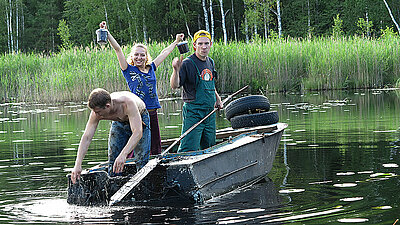Sapropel is an inland water sediment with a high content of organic matter. Sapropel has been formed in Latvian lakes for the last 12 000 years and its total volume in lakes and fens under peat layers is ~ 2 billion m3. Sapropel has a high potential for application, however, it is never fully exploited in practice. Its use is limited by the incompatibility of modern technologies with the properties of the resource and the increase in cost due to necessity of dehydration.
Research of sapropel can take a form of an independent study or be conducted as a part of the study exploring the past of the climate, or the ecosystem of lake. Investigation of sediment composition is important in environmental reconstruction, rehabilitation or landscape planning.
Specialists of the Natural Resource Research Centre of the University of Latvia have carried out sapropel studies in several lakes of Latvia, adapted the Freshwater classification system to Latvian conditions and tested it, developed and adapted various methods for sapropel research.
Access to high-quality cartographic material and sound skills in fieldwork will permit to promptly determine the most appropriate locations and methodology for sapropel sampling. Scientists have extensive experience in collecting water sediments for chemical, physical and microbiological analyses.
Available sampling equipment:
- modified piston drill – for removing poorly consolidated sediments from the top layer
- soft sediment drill – for removing intact consolidated sediment cores from deeper sediment layers
- Ekman type benthic grab – for sediment collection from beds
- cassettes and specialized containers for collecting sediment samples
- other necessary equipment: inflatable boat, GPS device, echo sounder, georadar
- moisture and dry matter
- ash and organic matter content
- carbonate content
- natural density
- bulk density of the material
- electrical conductivity
- granulometrical composition
- scanning electron microscopy (SEM)
- environmental reaction (pHH2O; pHKCl)
- elemental composition (C, H, N, O, S)
- metal concentrations by atomic absorption spectroscopy (AAS) or inductive bound plasma mass spectrometry (ICP-MS) method – total amount, water-soluble and insoluble, weak acid-soluble fraction (Cd, Cu, Pb, Ca, Mg, Na, Fe, Zn, Ni, Cr, Mn, K, As, Be, Co, Li, Mo, Se, Sr, Ti, Tl, Ba, V, Al, P, Sb)
- macro elements (N, P, K)
- nitrogen N (ammonium, nitrates, nitrites)
- phosphorus P (biogenic P, total P)
- potassium K (total, water-soluble and insoluble, weak acid-soluble potassium fraction)
- amount of humic substances: total content of humic substances, humic acids, fulvic acids
- measurements by infrared Fourier transform (FTIR) method
- measurements with the complex Ultraviolet-Visual (UV/Vis) method
- measurements by fluorescence method
- antioxidant content
- polyphenol content
- total sugars
Biological methods allow to determine the composition of the organic mass of sediments, in particular, the groups of forming organisms. Typically, these analyses are performed for sediment intervals of 1–5 cm thickness in the sediment layer of interest or in the whole profile, combined with the results of sediment dating (e.g., 14C and 210Pb). Such a study enables reconstruction of the past development of the climate, vegetation and the water body itself. By indirectly observing man-made pollution, the intensity of human impact on the water body can be determined in the layers of sediments, during whose formation human activities have appeared in the catchment area. The biological method, namely, the composition of the microfossils (biological composition), is important in determining the type of organogenic sapropel with an organic content of not less than 70%.
Biological methods used in sapropel research are divided into:
- pollen-spore composition. It shows the type of herbaceous plants and woody plants that used to form the overgrowth in the area around the water body during sapropel formation. For analysis, sapropel samples are boiled in acid to dissolve the material (detritus) that interferes with the counting and identification of pollen and spores. Samples are often stained for better observation of their shape and structure. Pollen and spore analysis used to be the only method to determine sediment age before the beginning of radiometrical sediment dating;
- composition of macrofossils (macro-residues). It allows to reconstruct the vegetation of the catchment area of the water body, which is determined by the regional factors of the area. Sediment samples are rinsed through a sieve with a mesh size of 250 µm. The stereomicroscope identifies the remains that remain on the sieve – various seeds and fruit skins, leaves and needles;
- composition of microfossils (micro-residues or biological composition). It permits reconstructing environmental conditions and changes in the water body itself, and is one of the basic parameters in determining the type of organogenic sapropel. Employing a light microscope, a smaller fraction of organic substances is observed in sapropel water extracts: various algae, cyanobacteria, residues of vascular plants and aquatic animals;
- composition of malacofauna. It reveals the mollusc species in sediments, identifying their species by shell remnants. The analysis can only be performed on carbonate sediments in which, due to the alkaline environment, the shells do not dissolve and remain preserved;
- microbiological composition. Colony forming units (CFU) of microorganisms are determined: Malt extract agar medium – moulds and yeasts; R2A medium – heterotrophic microorganisms; Endo medium – enterobacteria; Sulphate reducing medium; Anaerobic microorganism medium. The identification of microorganism species is performed using the BBL CrystalTM identification system.

 CONFERENCE
CONFERENCE